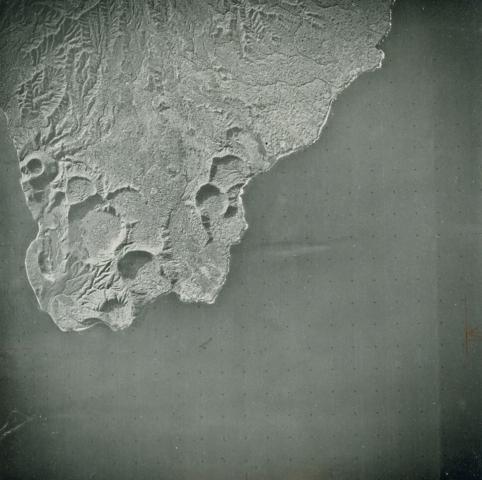
Other ITA web sites:

Ambrym Volcano, Vanuatu
This vertical aerial photo shows part of the 12-km-wide summit caldera of Ambrym volcano, one of the most active of the New Hebrides arc.
The two steaming craters at the upper left are Benbow (left) and Marum (right).
The caldera was formed during a major plinian eruption with dacitic pyroclastic flows about 1900 years ago.
Post-caldera eruptions, primarily from Marum and Benbow cones, have partially filled the caldera floor and also formed a series of scoria cones and maars along a fissure system oriented ENE-WSW.

The steep-walled craters of the Marum cone complex at the summit of Ambrym volcano are seen from the east.
Ambrym, a large basaltic volcano with a 12-km-wide caldera, is one of the most active volcanoes of the New Hebrides arc.
A thick, pyroclastic sequence, initially dacitic, then basaltic, overlies lava flows of a pre-caldera shield volcano.
Post-caldera eruptions, primarily from Marum and Benbow cones, have partially filled the caldera floor and produced lava flows that ponded on the caldera floor or overflowed through gaps in the caldera rim.

Boiling lava in the Marum crater, in September, 2009.

The ash-mantled slopes of the northern side of Marum cone are cut by erosional gulleys.
Marum is one of several historically active pyroclastic cones constructed with the 12-km-wide caldera; it lies in the west-central part of the caldera and at 1270 m is the highest of the post-caldera cones.

A series of basaltic tuff rings occupy the western tip of Ambrym Island, at the subaerial end of a fissure system that cuts across the length of the island. The largest tuff ring is about 1 km in diameter.
The tuff rings were produced by phreatic eruptions when magma contacted the water table or near-surface, water-saturated sediments along the coast.
At higher elevations along the rift zone, cinder cones predominate.

On May 27, 1988, this lava lake was observed in Mbwelesu's crater, which along with Marum, was emitting dark gray clouds.
Airline pilots had earlier reported ash clouds below 12-km altitude from Benbow on February 13.
Vanuatu geologists reported only increased activity from Benbow during February 12-14, after which the volcano returned to normal.
On August 9-10 lava flows that traveled towards the southern caldera wall were emitted from a new cone, Niri Taten, that formed on the south flank of Marum.
This eruption ended on August 23.

Incandescent spatter rises from a new lava lake at vent C of Mbwelesu crater at Ambrym volcano on August 28, 1999.
Mbwelesu crater was contructed at the eastern rim of Marum crater in the west-central part of the 12-km-wide summit caldera of Ambrym.
More frequent lava lake activity had been reported from several craters within the caldera since at least 1996 through the end of the century.
Lava lake activity had also been previously noted by infrequent visitors to the summit caldera during late late 1980s and the early 1990s.

Erosional gullies in fresh ash deposits dissect the northern slopes of Benbow, one of many pyroclastic cones in the summit caldera of Ambrym volcano.
This large basaltic volcano is one of the most active in the New Hebrides arc.
The 12-km-wide caldera was formed during a major plinian eruption with dacitic pyroclastic flows about 1900 years ago.
Post-caldera eruptions, primarily from Marum and Benbow cones, have partially filled the caldera floor and produced lava flows that ponded on the caldera floor or overflowed through gaps in the caldera rim.

A lava lake is visible inside Mbwelesu crater within Marum cone at Ambrym on June 7, 2007.
Lava lake activity was observed during a field expedition from May to June.
MODIS thermal alerts had resumed at Ambrym since November, 2006, and ash eruptions took place in March and April, 2007.

An ash plume from Ambryn volcano, seen from space, on October 4, 2004.

Ambrym was observed during a September 5-18, 1990 visit to Vanuatu to be ejecting ash and blocks from Niri Mbwelesu crater, which formed adjacent to Mbwelesu crater in 1989.
Mbwelesu was also active.
It appeared more elongated than represented on 1989 maps and no longer contained a lava lake.
Mbwelesu, Niri Mbwelesu, and Niri Mbwelesu Taten craters remained more or less constantly active into 1991.
PHOTO SOURCES: Alain Melchior, Royal Air Force and Hunting Surveys, London (published in Green and Short, 1971), Michel Lardy, 1990 (ORSTROM, Vanuatu), Karoly Nemeth, 2005 (Massey University), John Seach, 1999, Marco Fulle, 2000 (Stromboli On-Line, //stromboli.net) and Steven Clegg, 2007, courtesy of the Global Volcanism Program, Smithsonian National Museum of Natural History, used with permission; NASA.
NOTE: The information regarding Volcano on this page is re-published from other sources. No claims are made regarding the accuracy of Volcano information contained here. All suggestions for corrections of any errors about Volcano photos should be addressed to the copyright owner noted below the photo.